ABOUT GALAPAGOS BIRDING

NEOTROPICS GALAPAGOS
| Area (SqMi): | 4,897 |
| # Species: | 187 |
| # Excl Vagrants: | 98 |
| # Endemics: | 31 |
| # Near Endemics: | 0 |
| Species/1000 SqMi: | 20.0 |
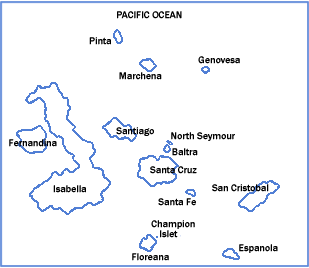 Below is a brief summary of the important islands to visit during a Galapagos birding tour and what the important bird species are on each island. The names used are the current Spanish names, with the former British names given in parentheses.
Below is a brief summary of the important islands to visit during a Galapagos birding tour and what the important bird species are on each island. The names used are the current Spanish names, with the former British names given in parentheses.
BALTRA (SOUTH SEYMOUR) ISLAND
Baltra is a small island near the larger Santa Cruz Island. It's the embarkation/debarkation point for many Galapagos cruises. Daily flights from Guayaquil (or Quito via Guayaquil) bring tourists to and from the islands through the airport on Baltra. Baltra is not a major birding locale, but it offers new arrivals their first introduction to Galapagos endemics, including Medium Ground-Finch and Small Ground-Finch. A short bus trip transfers tour participants across the island to the embarkation point, where marine birds such as Elliott's Storm-Petrel, Magnficent Frigatebird, Blue-footed Booby, and Nazca Booby can be seen. We also saw a very rare (for the islands) Black Tern flying near the dock.
NORTH SEYMOUR ISLAND
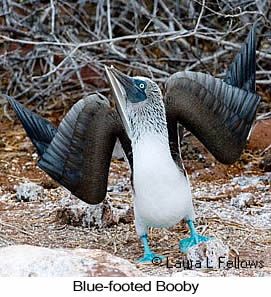 North Seymour is a small, flat island not far north of Baltra and Santa Cruz. A dry landing gives visitors access to a loop trail around the island. Marine Iguanas are found in the rocks and Galapagos Sea Lions are present on sandy beaches and sometimes on the flat path that circles the island. Baltra hosts major nesting colonies of Magnificent Frigatebirds and Blue-footed Boobies. Peak mating season is May-June but nests are still active most of the year. There appears to be a second mating season for boobies in November, as we saw many individuals courting there at that time of year. The beautiful Swallow-tailed Gull also nests on the island. Other birds found on Baltra include Lava Heron, Lava Gull, Common Noddy, Small Ground-Finch, and Medium Ground-Finch.
North Seymour is a small, flat island not far north of Baltra and Santa Cruz. A dry landing gives visitors access to a loop trail around the island. Marine Iguanas are found in the rocks and Galapagos Sea Lions are present on sandy beaches and sometimes on the flat path that circles the island. Baltra hosts major nesting colonies of Magnificent Frigatebirds and Blue-footed Boobies. Peak mating season is May-June but nests are still active most of the year. There appears to be a second mating season for boobies in November, as we saw many individuals courting there at that time of year. The beautiful Swallow-tailed Gull also nests on the island. Other birds found on Baltra include Lava Heron, Lava Gull, Common Noddy, Small Ground-Finch, and Medium Ground-Finch.
SANTA CRUZ (INDEFATIGABLE) ISLAND
 Santa Cruz Island is the second largest and most populated island in the Galapagos. The Charles Darwin Research Station is located at Puerto Ayora on the island and is an international research center where scientific work on the islands is based. The research center has a variety of captive Galapagos marine animals and birds, including a few that are the only remaining individuals for the species or subspecies.
Santa Cruz Island is the second largest and most populated island in the Galapagos. The Charles Darwin Research Station is located at Puerto Ayora on the island and is an international research center where scientific work on the islands is based. The research center has a variety of captive Galapagos marine animals and birds, including a few that are the only remaining individuals for the species or subspecies.
Darwin Station is an excellent place to see Giant Tortoises. These tortoises are also found in the highland tortoise reserve on the island. Marine Iguanas are quite common along the shores of nearby Academy Bay, though the population has been declining in recent years. Lava Herons and various seabirds and shorebirds are found in the area and at nearby Tortuga Bay, as are several species of Darwin's finches.
On the north side of the island is a white sand beach, Las Bachas, where tour boats sometimes stop at the beginning of a cruise because of its proximity to Baltra. The beach is best known as a nesting site for Galapagos Green Sea Turtles, which are mating and beginning to come ashore in November to lay their eggs. Birds found in the nearby lagoons include American Flamingo, White-cheeked Pintail, and a variety of shorebirds. Colorful Sally Lightfoot Crabs are common on the rocks, as they are throughout the islands.
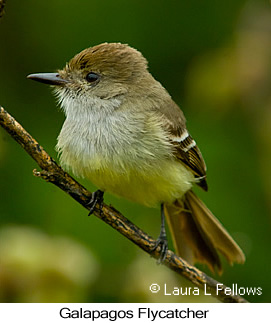 Cerro Dragon (Dragon Hill) is a very dry upland habitat on Santa Cruz Island. The main attraction is the small population of Galapagos Land Iguanas found there. White-cheeked Pintail are also present, as are Large Ground-Finch and Common Cactus-Finch.
Cerro Dragon (Dragon Hill) is a very dry upland habitat on Santa Cruz Island. The main attraction is the small population of Galapagos Land Iguanas found there. White-cheeked Pintail are also present, as are Large Ground-Finch and Common Cactus-Finch.
Media Luna is one of the large volcanic craters in the highlands of Santa Cruz Island. Possible birds found there include Peregrine Falcon and Galapagos Rail. The latter species is extremely secretive and only likely to be seen if the tour is accompanied by an expert guide who knows where and how to find them. Another rather difficult bird to see is the Painted Crake, a beautiful rail also found on the mainland of South America. We've seen Painted Crakes at two locales on the slopes of Media Luna. Other birds in the highlands include Galapagos Flycatcher, Small Tree-Finch, and Woodpecker Finch. The Woodpecker Finch is famous for its habit of using cactus spines to probe insects out of tree crevices, a rare example of tool-using in birds.
GENOVESA (TOWER) ISLAND
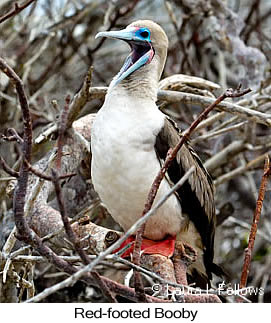 Genovesa is a small, horseshoe-shaped, somewhat outlying island. Reaching the island requires sailing all night from Baltra, so most tour boats don't visit it. Nevertheless, Genovesa is an important stop on birding tours because it's home to the largest colony of Red-footed Booby in the world. Red-footed Boobies are rarely sighted anywhere else in the Galapagos, and then only at sea. The colony is located at Darwin Bay and requires a wet landing where visitors must wade ashore in knee-deep water. A short uphill trail allows access to the colony. Red-footed Boobies nest in trees, unlike other booby species, and lay only one egg per season presumably because they range far at sea to forage and are unable to rear more than one young at a time.
Genovesa is a small, horseshoe-shaped, somewhat outlying island. Reaching the island requires sailing all night from Baltra, so most tour boats don't visit it. Nevertheless, Genovesa is an important stop on birding tours because it's home to the largest colony of Red-footed Booby in the world. Red-footed Boobies are rarely sighted anywhere else in the Galapagos, and then only at sea. The colony is located at Darwin Bay and requires a wet landing where visitors must wade ashore in knee-deep water. A short uphill trail allows access to the colony. Red-footed Boobies nest in trees, unlike other booby species, and lay only one egg per season presumably because they range far at sea to forage and are unable to rear more than one young at a time.
Also found on Genovesa is a large mixed colony of Magnificent and Great Frigatebirds. Great Frigatebirds nest primarily on Genovesa and are rarely seen elsewhere in the islands. Primary mating season is May-June, and nesting is in full swing by July. Frigates can be seen inflating their gular pouches whenever they're present on the nesting colony, but prime time is the mating season. It can take a bird 20 minutes to fully inflate its pouch.
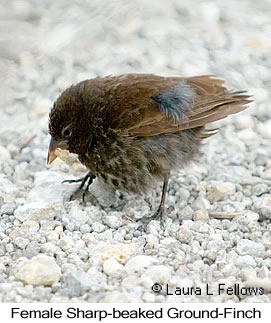 Many frigates of both species are still feeding young into December, though by that time of year mating displays are uncommon and rather half-hearted. Other marine birds found along the shoreline and in nearby waters include Wedge-rumped Storm-petrel, Red-billed Tropicbird, Swallow-tailed Gull, and Lava Gull.
Many frigates of both species are still feeding young into December, though by that time of year mating displays are uncommon and rather half-hearted. Other marine birds found along the shoreline and in nearby waters include Wedge-rumped Storm-petrel, Red-billed Tropicbird, Swallow-tailed Gull, and Lava Gull.
Genovesa is the best place to see Sharp-beaked Ground-Finch, as it is readily seen along the trail from the beach. The species is also found in dry vegetation at higher elevation on Santiago, Pinta, and Fernandina Islands and on several other small islets but in areas not usually visited by tour groups. Other species of Darwin's finches on the island include Large Ground-Finch, Large Cactus-Finch, and Warbler Finch.
FERNANDINA ISLAND
 Fernandina is one of the youngest and most geologically active islands in the Galapagos. It's one of the least visited islands because it's located west of Isabella off the main cruise routes. The island is mainly visited by boats stopping along the western side of Isabella because it's not otherwise worth traveling so far to see. A dry landing at Punta Espinoza allows exploration of the island. The trail goes through black lava beds devoid of vegetation other that lava cactus. Fernandina is an excellent place to see Galapagos Penguin and Flightless Cormorant. A variety of other seabirds can be seen around the island, along with land birds such as Galapagos Mockingbird and several species of Darwin's finches. The island also boasts a large population of Galapagos Land Iguanas.
Fernandina is one of the youngest and most geologically active islands in the Galapagos. It's one of the least visited islands because it's located west of Isabella off the main cruise routes. The island is mainly visited by boats stopping along the western side of Isabella because it's not otherwise worth traveling so far to see. A dry landing at Punta Espinoza allows exploration of the island. The trail goes through black lava beds devoid of vegetation other that lava cactus. Fernandina is an excellent place to see Galapagos Penguin and Flightless Cormorant. A variety of other seabirds can be seen around the island, along with land birds such as Galapagos Mockingbird and several species of Darwin's finches. The island also boasts a large population of Galapagos Land Iguanas.
Following a dry landing, a short walk into the mangroves at Punta Espinoza can yield American Flamingo and White-cheeked Pintail. This locale is also one of the few places where the very rare Mangrove Finch can still be found, though it may now be extirpated.
ISABELA ISLAND
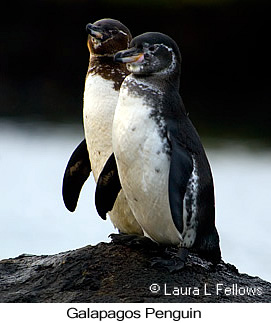 Isabela Island is located in the center of the Galapagos, near Fernandina, and is the largest island in the Galapagos. It's typically reached by sailing around the north end from Genovesa, a long passage that takes most of the night. This passage is a major attraction for birding tours because it's one of the few places where the now rare Galapagos Shearwater can still be seen for those persistent enough to watch for them above decks. The seas during this passage are generally rougher than elsewhere in the Galapagos because it's open ocean with currents unobstructed by nearby islands.
Isabela Island is located in the center of the Galapagos, near Fernandina, and is the largest island in the Galapagos. It's typically reached by sailing around the north end from Genovesa, a long passage that takes most of the night. This passage is a major attraction for birding tours because it's one of the few places where the now rare Galapagos Shearwater can still be seen for those persistent enough to watch for them above decks. The seas during this passage are generally rougher than elsewhere in the Galapagos because it's open ocean with currents unobstructed by nearby islands.
The western side of Isabela is covered by fairly young lava fields that create a lunar-like landscape. The upwelling waters of the Cromwell Current off the west coast create a feeding ground for whales, porpoises, and seabirds. This is the best place to see whales, including possibly Right Whale, Humpback Whale, Sperm Whale, Minke Whale, and Orcas. Located nearby is the largest nesting area for Galapagos Penguins and Flightless Cormorants. Also found on the island are American Flamingo, Lava Heron, Galapagos Dove, Dark-billed Cuckoo, Galapagos Mockingbird, Medium Ground-Finch, Small Ground-Finch, and Mangrove Finch. Thousands of Red-necked Phalaropes and much smaller numbers of Red Phalaropes can be seen flying over the ocean near the island. More tortoises are found on Isabela than all other islands combined.
Elizabeth Bay on the western side is an important nesting site for Green Sea Turtles, which are most common from November to February. The bay is ringed by mangroves and is one of the very few places where the now extremely endangered Mangrove Finch is still found. For this reason, Elizabeth Bay is a prized stop for birding groups visiting the Galapagos.
FLOREANA (CHARLES) ISLAND AND CHAMPION ISLET
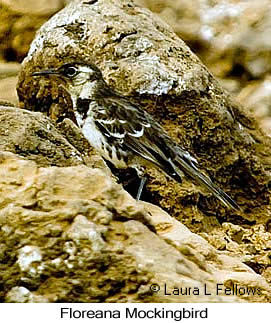 Floreana Island is best known for its colorful history of pirates, whalers, convicts, and buccaneers who frequented the island in the eighteenth and nineteenth centuries. Devil's Crown, located not far offshore, is an old eroded volcanic cone that offers probably the best snorkeling anywhere in the Galapagos. Here one can see a great variety of reef fish, garden eels that protrude from holes on the seabed, and in deeper waters farther out harmless hammerhead and reef sharks.
Floreana Island is best known for its colorful history of pirates, whalers, convicts, and buccaneers who frequented the island in the eighteenth and nineteenth centuries. Devil's Crown, located not far offshore, is an old eroded volcanic cone that offers probably the best snorkeling anywhere in the Galapagos. Here one can see a great variety of reef fish, garden eels that protrude from holes on the seabed, and in deeper waters farther out harmless hammerhead and reef sharks.
A number of marine birds can be seen around Floreana, including Galapagos Penguin, Red-billed Tropicbird, Blue-footed Booby, Nazca Booby, and Swallow-tailed Gull. Land birds on the island include Galapagos Flycatcher, Medium Ground-Finch, Small Ground-Finch, Medium Tree-Finch, and Small Tree-Finch.
Nearby Champion Islet is the only place where the endemic Charles Mockingbird is found. Tourists are not allowed to go ashore, but the mockingbird is readily seen around the dry vegetation and rocks along the shoreline. A substantial rookery of Galapagos Sea Lions is also found on the islet.
ESPANOLA (HOOD) ISLAND
 Espanola is the southeastern-most and hence oldest of the Galapagos Islands. It is best known as the primary nesting site of the Waved Albatross and is a must-see destination for any birding tour. Waved Albatrosses are uncommonly seen elsewhere in the islands and then only at sea. Mating season for the albatrosses begins in April and is in full swing during May-July. Birds are in the colony into December, but by late November or early December very few adults are still present. The only other nesting site of Waved Albatross in the world is a small island off the coast of Ecuador.
Espanola is the southeastern-most and hence oldest of the Galapagos Islands. It is best known as the primary nesting site of the Waved Albatross and is a must-see destination for any birding tour. Waved Albatrosses are uncommonly seen elsewhere in the islands and then only at sea. Mating season for the albatrosses begins in April and is in full swing during May-July. Birds are in the colony into December, but by late November or early December very few adults are still present. The only other nesting site of Waved Albatross in the world is a small island off the coast of Ecuador.
Four species of mockingbirds are found in the Galapagos Islands. The Galapagos Mockingbird is found on nearly all the islands, but the others are restricted to just one island each. One of those is the Hood Mockingbird, an endemic found only on Espanola. This is yet another reason why Espanola is a must-see stop on any birding tour of the Galapagos.
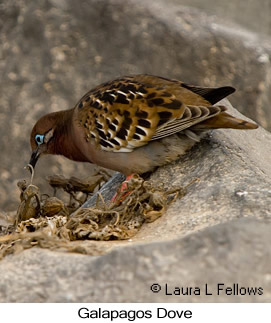 In addition to the above, Espanola is home to one of the largest nesting colonies of Blue-footed Booby in the Galapagos. Numerous Nazca Boobies also nest on the island, as do many Red-billed Tropicbirds and Swallow-tailed Gulls. Many Marine Iguanas are found on the rocks along the shoreline, and the largest species of Lava Lizard can be seen throughout the island. Other seabirds found around the island include Galapagos Petrel, Elliot's Storm-petrel, Wedge-rumped Storm-petrel, and Audubon's Shearwater. A variety of land birds are found on the island, including Galapagos Hawk, Galapagos Dove, Small Ground-Finch, Large Cactus-Finch, and Warbler Finch.
In addition to the above, Espanola is home to one of the largest nesting colonies of Blue-footed Booby in the Galapagos. Numerous Nazca Boobies also nest on the island, as do many Red-billed Tropicbirds and Swallow-tailed Gulls. Many Marine Iguanas are found on the rocks along the shoreline, and the largest species of Lava Lizard can be seen throughout the island. Other seabirds found around the island include Galapagos Petrel, Elliot's Storm-petrel, Wedge-rumped Storm-petrel, and Audubon's Shearwater. A variety of land birds are found on the island, including Galapagos Hawk, Galapagos Dove, Small Ground-Finch, Large Cactus-Finch, and Warbler Finch.
Gardner Bay on the east side of Espanola is a favorite tourist attraction featuring white-sand beaches, a sea lion colony, and excellent snorkeling. Between October and December Galapagos Green Sea Turtles are commonly seen mating just off shore.
SAN CRISTOBAL ISLAND
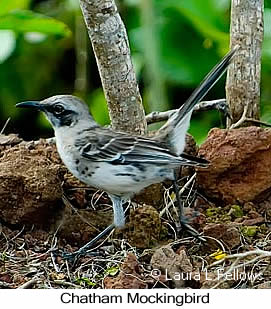 San Cristobal is the administrative center of the Galapagos Islands. Some Galapagos tours begin and end at the small airport on the island instead of Baltra. Although San Cristobal is the second most populous island in the Galapagos, it has its natural attractions. The Chatham Mockingbird nests only on San Cristobal, and several species of Darwin's finches can be seen there including Medium Ground-Finch, Small Ground-Finch, Vegetarian Finch, Small Tree-Finch, Woodpecker Finch, and Warbler Finch. The shallow waters of the bay are a good place to see Elliot's Storm-Petrel, as are shallow water bays of some other islands. A variety of seabirds can be seen in surrounding waters, including various petrels, Blue-footed Booby, and Nazca Booby.
San Cristobal is the administrative center of the Galapagos Islands. Some Galapagos tours begin and end at the small airport on the island instead of Baltra. Although San Cristobal is the second most populous island in the Galapagos, it has its natural attractions. The Chatham Mockingbird nests only on San Cristobal, and several species of Darwin's finches can be seen there including Medium Ground-Finch, Small Ground-Finch, Vegetarian Finch, Small Tree-Finch, Woodpecker Finch, and Warbler Finch. The shallow waters of the bay are a good place to see Elliot's Storm-Petrel, as are shallow water bays of some other islands. A variety of seabirds can be seen in surrounding waters, including various petrels, Blue-footed Booby, and Nazca Booby.
SANTIAGO (JAMES) ISLAND
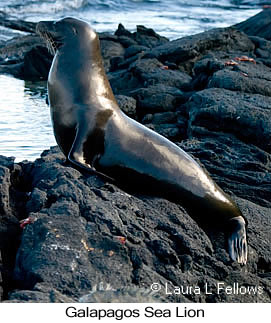 The east coast of Santiago Island is covered by coiled black volcanic lava flows. A major highlight on the island are the reddish-black Marine Iguanas and the Galapagos Land Iguanas found on the lava beds. Galapagos Fur Seals and Galapagos Sea Lions can be seen along the rocky coastline and in the waters of Sullivan Bay. Some of the best tide pools in the Galapagos are found along the black sand beaches at Puerto Egas on the western shore.
The east coast of Santiago Island is covered by coiled black volcanic lava flows. A major highlight on the island are the reddish-black Marine Iguanas and the Galapagos Land Iguanas found on the lava beds. Galapagos Fur Seals and Galapagos Sea Lions can be seen along the rocky coastline and in the waters of Sullivan Bay. Some of the best tide pools in the Galapagos are found along the black sand beaches at Puerto Egas on the western shore.
BARTOLOME ISLAND
Bartolome Island is a small island located east of Santiago Island. Bartolome is a rather barren, vegetation-less volcanic cone. It's the most visited island in the Galapagos and also the most photographed because of its stark pinnacle rocks. It's a popular snorkeling locale and is a major mating and nesting site of Green Sea Turtles. The most important birds of interest on the island are Galapagos Penguin and Galapagos Hawk.
WHY VISIT THE GALAPAGOS ISLANDS
 The Galapagos Islands are known throughout the world as the Enchanted Islands. Nowhere else can one find such a uniquely remote, windswept, intriguing, scientifically important archipelago as these islands. The lack of freshwater made the islands virtually uninhabitable until modern times, and their remoteness made them home to pirates, adventurers, seabirds, and amazingly different iguanas and birds that mostly survive to this day. The Galapagos Islands are perhaps best known for inspiring Darwin's concept of natural selection and his book The Origin of Species. They remain a vast wildlife refuge owned and carefully regulated by Ecuador. Many outlying islands and atolls are off limits to everyone but scientists, and all tourism to the islands is carefully regulated by the Galapagos National Park Service. No one is allowed to live permanently on the islands except those born there, and yet the islands are suffering today from overpopulation and the heavy impact of tourism. The birds are habituated to humans, allowing very close approach and easy photography as well as viewing. The islands offer 29 endemic birds as well as many seabirds not readily seen in the continental US or South America.
The Galapagos Islands are known throughout the world as the Enchanted Islands. Nowhere else can one find such a uniquely remote, windswept, intriguing, scientifically important archipelago as these islands. The lack of freshwater made the islands virtually uninhabitable until modern times, and their remoteness made them home to pirates, adventurers, seabirds, and amazingly different iguanas and birds that mostly survive to this day. The Galapagos Islands are perhaps best known for inspiring Darwin's concept of natural selection and his book The Origin of Species. They remain a vast wildlife refuge owned and carefully regulated by Ecuador. Many outlying islands and atolls are off limits to everyone but scientists, and all tourism to the islands is carefully regulated by the Galapagos National Park Service. No one is allowed to live permanently on the islands except those born there, and yet the islands are suffering today from overpopulation and the heavy impact of tourism. The birds are habituated to humans, allowing very close approach and easy photography as well as viewing. The islands offer 29 endemic birds as well as many seabirds not readily seen in the continental US or South America.
OTHER COUNTRIESIN THE NEOTROPICS
BIRDING LOCALES





